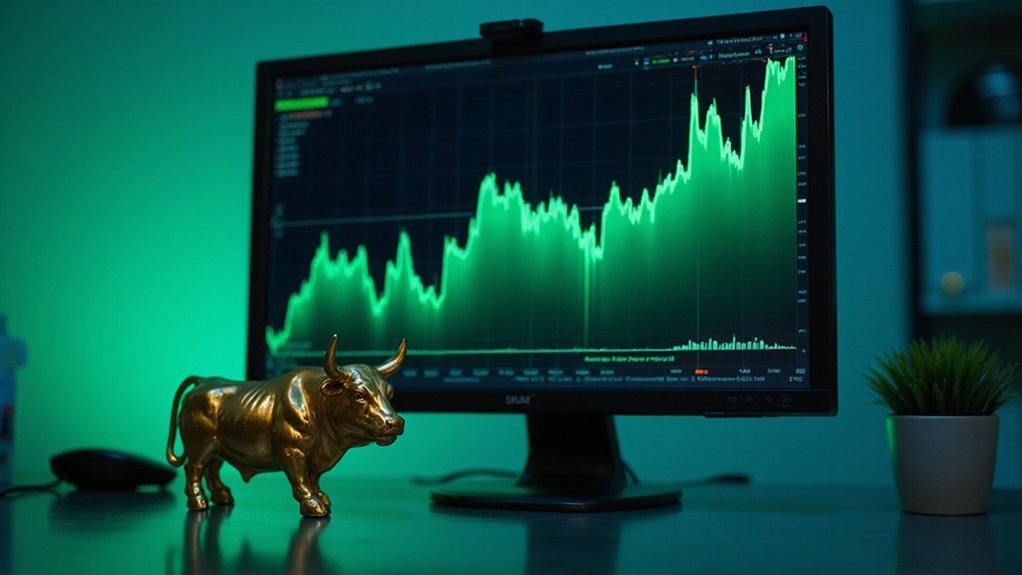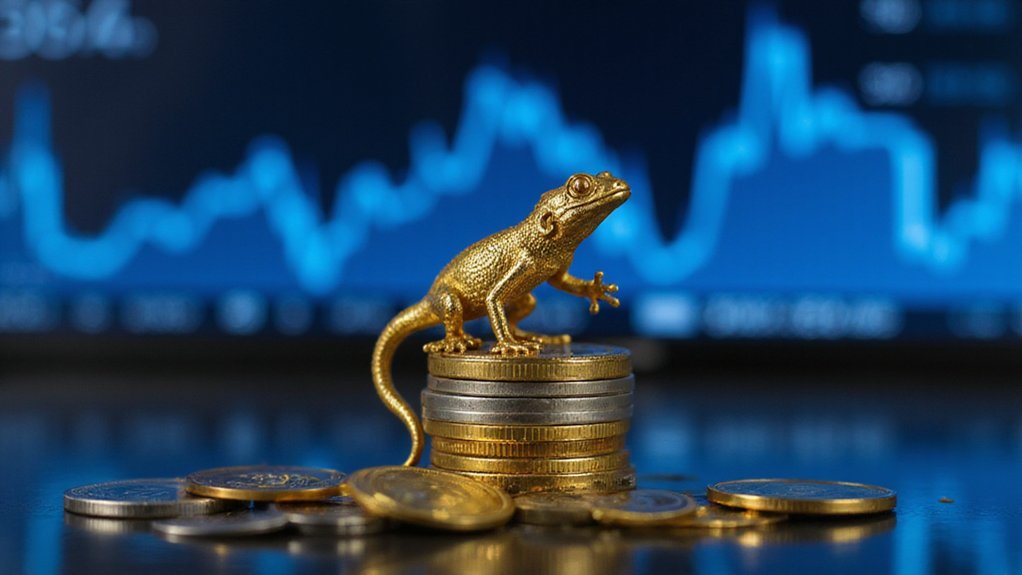A crypto bull run represents a sustained price appreciation of 20% or more from recent lows across major digital assets. These euphoric periods feature heightened trading volumes, intense FOMO-driven participation, and positive media coverage creating a self-reinforcing cycle. Historical examples include Bitcoin’s rise to $20,000 in 2017 and its $69,000 peak during 2020-2021. Catalysts often include halving events, institutional adoption, and regulatory clarity—though savvy investors recognize that bull markets inevitably attract both fortune-seekers and fraudsters alike.

A bull run in cryptocurrency markets represents that peculiar financial phenomenon where digital assets experience sustained, significant price appreciation—typically defined as 20% or more growth from recent lows across major tokens like Bitcoin.
These exuberant periods stand in stark contrast to their ursine counterparts (bear markets) and can persist for surprisingly extended timeframes, as evidenced by the approximately year-long euphoria that gripped markets from 2020 to 2021.
The unmistakable hallmarks of these financial festivities include heightened trading volumes, intensified market participation, and that most human of investment catalysts: FOMO¹.
As prices ascend to dizzying heights, positive media coverage creates a self-reinforcing cycle where demand consistently outpaces available supply.
The relentless dance of headlines and FOMO propels prices skyward—a financial feedback loop of boundless appetite confronting finite tokens.
One observes, with a mixture of fascination and trepidation, how rationally-minded investors transform into momentum-chasing enthusiasts as their portfolios expand exponentially—a psychological metamorphosis as old as markets themselves.
Historical precedents provide instructive examples: 2017 witnessed Bitcoin’s meteoric rise to $20,000 amid an ICO frenzy; 2020-2021 saw BTC touch $69,000 while DeFi protocols and pixelated JPEGs commanded astronomical valuations.
Common catalysts for these upward trajectories include Bitcoin halving events, regulatory clarifications, technological breakthroughs, and—somewhat amusingly—the occasional Elon Musk tweet.
Prudent investors approach these periods with strategic frameworks: dollar-cost averaging, portfolio rebalancing at peak valuations, and vigilant monitoring of whale wallet movements.
The allure of overnight wealth generation often obscures lurking hazards: overleveraging, proliferation of fraudulent projects, and the omnipresent specter of regulatory intervention.
While bull runs represent potentially lucrative opportunities, they paradoxically breed the very excesses that ultimately terminate them.
The cryptocurrency market’s relative immaturity amplifies these boom-bust cycles, creating an environment where spectacular gains coexist with precipitous corrections—a financial ecosystem where fortune favors not just the bold, but the disciplined.
The entrance of major financial institutions into the cryptocurrency space often serves as a powerful catalyst for bull runs by signaling increased legitimacy and attracting both retail investors and additional institutional capital.
Similar to traditional markets, crypto bull runs typically coincide with periods of robust economic growth and high investor confidence that fuel demand for higher-risk assets.
When analyzing bull markets, investors should remain vigilant for signs of declining confidence, as unfavorable legislation or significant world events can trigger a sudden trend reversal and mark the beginning of a bear market.
¹Fear Of Missing Out, that timeless affliction of investors watching others profit.
Frequently Asked Questions
How Long Does a Typical Crypto Bull Run Last?
Crypto bull runs typically last between 4-8 months, though historical data reveals considerable variance.
The 2013-2014 and 2017-2018 cycles compressed into roughly 104 and 165 days respectively, while the anomalous 2020-2021 run stretched to 473 days.
Market maturation and institutional involvement appear to elongate these cycles, with Bitcoin halvings serving as reliable catalysts.
External factors—regulatory interventions, macroeconomic shifts, and retail FOMO peaks—frequently determine when the music stops (often abruptly).
What Triggers the End of a Crypto Bull Market?
Crypto bull markets typically terminate through a confluence of factors rather than a single catalyst.
Technical indicators like RSI overbought conditions and broken support levels often coincide with socioeconomic shifts including deteriorating sentiment and regulatory crackdowns.
Market mechanisms (the inevitable correction of astronomical valuations) and external pressures (central bank tightening, geopolitical tensions) further contribute to the denouement.
The end frequently arrives not with a whimper but a crescendo of volatility—a final parabolic move before the inevitable correction.
Can Altcoins Outperform Bitcoin During Bull Runs?
Altcoins frequently outperform Bitcoin during bull runs as investors chase higher-risk, higher-reward opportunities.
Historical data confirms this pattern, with select altcoins delivering returns that eclipse BTC by significant margins when Bitcoin dominance (BTC.D) declines.
Technical indicators—including Elliott Wave completions and the Altcoin Season Index hovering around 55—suggest we’re witnessing the early stages of this phenomenon.
Recent outperformers like XCN, OM, and JUP exemplify this trend, though such outperformance comes with proportionally elevated security and ecosystem-specific risks.
How to Identify Early Signs of a Crypto Bull Run?
Early crypto bull run indicators emerge across multiple fronts: surging market capitalization beyond established support levels, declining Bitcoin dominance as altcoins gain traction, RSI readings approaching 70, and prices consistently outperforming moving averages.
On-chain metrics—rising transaction volumes and active addresses—often precede price action, while sentiment indicators like institutional adoption and increasing social buzz provide confirmation.
Technical analysts particularly monitor volume patterns and VWAP for institutional entry points, alongside cross-market correlations that historically telegraph impending rallies before retail awareness peaks.
Should Investors Take Profits During a Bull Run or Hodl?
Investors face the classic crypto conundrum during bull runs: capture profits or ride the wave? The answer—predictably—depends on individual circumstances.
A balanced approach often proves ideal: taking partial profits (particularly when assets reach predetermined thresholds) while maintaining core positions.
Risk tolerance, time horizon, and overall portfolio strategy should guide these decisions.
Dollar-cost averaging out can mitigate timing risks, while strategic HODLing preserves exposure to potential upside—though neither approach offers immunity from the market’s notorious volatility.









